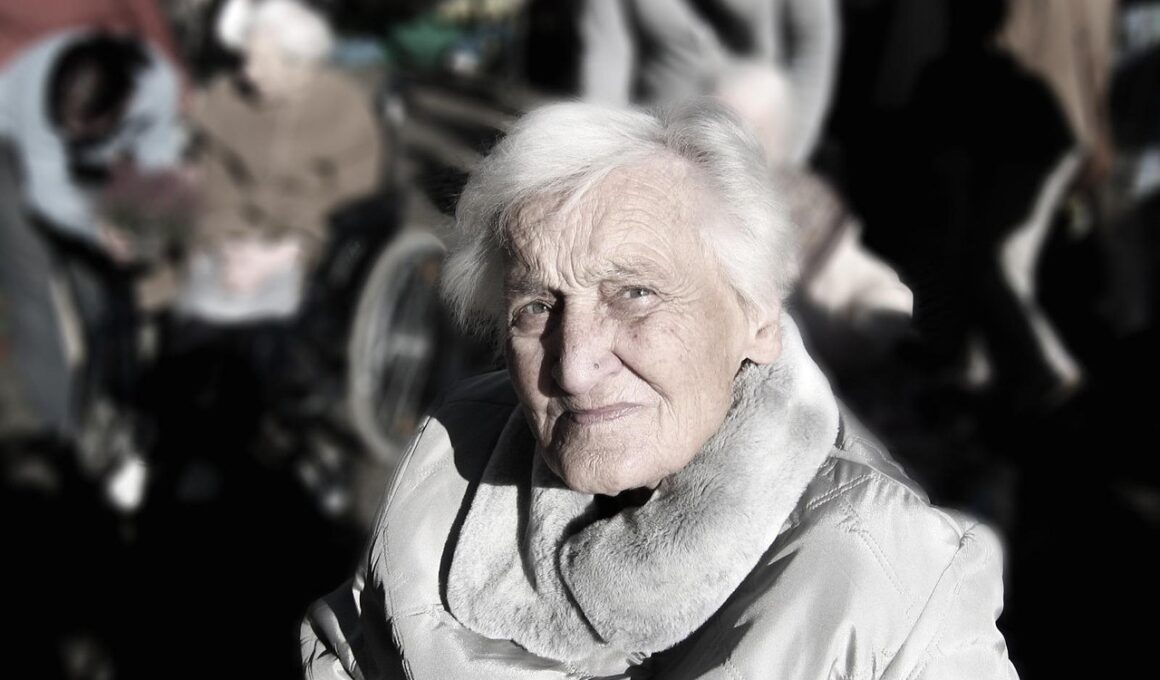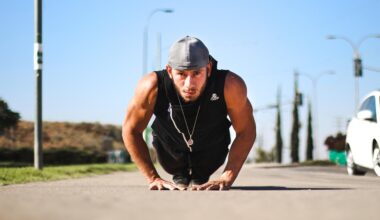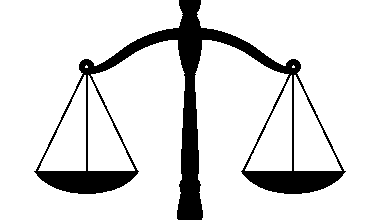Simple Daily Balance Routines for Older Adults
Maintaining balance and coordination is vital for older adults to prevent falls and injuries. Regularly practicing balance exercises can help enhance stability, improve strength, and build confidence in daily activities. Incorporating simple routines into their daily lives can lead to significant benefits. For seniors, it’s essential to start with easy exercises that do not require advanced skills or heavy physical exertion. A few minutes each day can make a substantial difference in physical capability. Ensuring that the environment is safe, free of hazards, encourages practicing movements that reinforce stability. Encourage employing a sturdy chair or handrail for support during exercises to enhance feelings of security. Creating a consistent routine that includes balance practice fosters a sense of accomplishment. Routine can help transform balance exercises into lifelong habits, which contribute to a healthier lifestyle. Focus on slow, controlled movements and work at a comfortable pace. This approach promotes better muscle memory and integration of skills into daily activities. Seeking guidance from healthcare professionals or trainers can also assist in selecting proper exercises tailored for individual needs, ensuring optimal safety and efficacy during practice.
One essential exercise for older adults is standing on one leg. This easy yet effective exercise can significantly enhance balance. To perform this move, simply hold onto the back of a chair for support while lifting one leg off the ground. Try maintaining this position for ten seconds before switching legs. This can be repeated several times, and as stability improves, try to do it without holding onto the chair. Incorporating toe stands is another powerful routine to boost balance. Stand straight and slowly rise onto your toes, holding the position for a few seconds before returning to flat feet. This directly engages calf muscles and improves stability. To diversify routines, consider involving walking heel to toe. This means walking in a straight line, placing the heel of one foot just in front of the toes of the other foot. This helps develop coordination and strengthens foot muscles. Engaging in yoga or tai chi provides an excellent way to incorporate balance, flexibility, and strength in a gentle manner. Weekly classes tailored for seniors can offer social interactions while promoting overall well-being and confidence in movements.
Incorporate Stretching into Daily Routines
Stretching is an integral part of balance routines that should not be overlooked by older adults. Performing stretches not only improves flexibility but also enhances coordination by allowing the body to move more freely. A simple upper body stretch can include reaching both arms above the head, slowly and gently leaning side to side, stretching the back and sides. Follow this with a lower body stretch such as sitting down in a chair and extending one leg while keeping it straight, feeling a light stretch in the back of the leg. The key is to breathe deeply and hold each stretch for about 15 to 30 seconds to achieve optimal results. Furthermore, using a resistance band during stretches can enhance muscle engagement, which allows for a better balance. Adding a balance board or a soft surface while stretching boosts the challenge and encourages muscles to engage more effectively. Older adults can easily incorporate these stretching routines into their mornings or before bed. Finding enjoyable stretching and balance exercises through videos or local classes can make this process engaging and fruitful, promoting consistency.
Strength training complements balance routines excellently, providing physical resilience that is crucial for coordinating movements. Engaging seniors in light strength training using dumbbells or resistance bands can greatly improve muscle strength. Focus on exercises that target the core, legs, and back for sturdy foundational support. Examples include seated leg lifts, chair squats, or using bands for resistance overhead. These activities help in building muscle around the legs, arms, and core, providing better support during everyday movements. Engaging in resistance activities at least twice a week helps seniors maintain independence and mobility. Additionally, functional movements, such as carrying groceries or standing from a seated position, can enhance everyday balance. Learning proper techniques to perform tasks without losing balance is crucial. Ensure to start with low weight or resistance and focus more on form than intensity. Pairing strength training with aerobic activities like walking or swimming enhances stamina and overall fitness. Always consult with fitness professionals or doctors before starting any new program to ensure the exercises are safe and appropriate to individual conditions and health statuses.
Group Classes and Social Engagement
Participating in group classes specifically designed for balance training offers a sense of community while improving physical skills. Many local community centers or gyms provide classes tailored to older adults, focusing on strength, flexibility, and balance enhancement. These classes are often led by trained instructors who understand the needs of older learners. The environment encourages socializing and rapport-building among participants, contributing to overall mental well-being. Engaging with peers makes routine exercise enjoyable and less daunting for those new to physical activities. Joining exercise groups not only promotes physical fitness but enhances motivation through shared experiences. For those who may feel isolated, these classes can provide a much-needed connection. Alternative forms of social engagement, such as hobby groups or walking clubs, encourage seniors to stay active with peers. In addition, conducting balance exercises while socializing can normalize fitness endeavors. Research indicates that having a support system encourages consistent exercise habits among seniors. By creating enjoyable settings for movement, seniors can establish and sustain a commitment to their health and wellness journey in the long term.
Creating a safe exercise environment at home is vital for effective routines aimed at enhancing balance. This can include decluttering spaces, ensuring obstacles and tripping hazards are removed, and providing adequate lighting, especially in areas prone to falls such as staircases. Installing grab bars in bathrooms and non-slip mats can also promote safety, making it easier for seniors to practice balance exercises fearlessly. Designating a consistent space at home for regular practice encourages adherence to routines. This could involve a living room with ample open space or a garden area where fresh air complements exercise. Using supportive footwear and avoiding slippery socks can further reduce risks during exercises. Keep water accessible to stay hydrated while practicing routines. Recording progress can inspire seniors to continue with their routines and observe improvements in strength and balance. Engaging family members to monitor and join seniors during exercises not only boosts motivation but also reinforces the importance of balanced routines in everyday life. Technology aids in facilitating safe home exercises through instructional videos and community resources available online, leading to tailored plans that encourage participation in balance routines.
Mind and Body Connection for Balance
Emphasizing the mind-body connection enhances balance routines for older adults, as achieving mental focus optimizes performance. Introducing mindfulness through breathing techniques can assist older adults in centering their thoughts during balance exercises. Incorporating simple practices into routines, such as taking deep breaths or visualizing a steady posture, can improve concentration and reduce anxiety. This meditative approach cultivates body awareness, allowing seniors to detect shifts in balance proactively. Mindfulness helps them feel more grounded and less fearful while engaging in movement. Additionally, practicing mindfulness helps in alleviating feelings of stress or physical discomfort, which often hinder performance. Meditation techniques can also encourage better cognitive function, which is crucial for coordination and movement. Enabling a peaceful mindset while moving reinforces successful execution of exercises. This, in turn, leads to greater overall success in maintaining physical activity, as the positivity cultivated through this practice transcends beyond just balance exercises. Fostering a holistic approach, where physical and mental elements are intertwined, paves a broader path toward improved health and vitality for older adults. Many programs combine these elements seamlessly, capitalizing on both the mind and body for effective training of balance skills.
In conclusion, prioritizing balance and coordination exercises into daily lives of older adults is paramount for their independence and overall health. Simple routines can be performed regularly during their day-to-day activities without requiring significant time investments. Engaging in a blend of stretching, strength training, and mindfulness practices fosters a comprehensive approach that contributes towards longevity in mobility. By gradually increasing exercise intensity and variety, seniors can enhance their overall physical capability in a way that feels rich and rewarding. It is essential that older adults feel equipped, both physically and mentally, to participate in their routines actively. Family support and encouragement play critical roles in ensuring adherence to balance exercises, creating a nurturing environment. Continuous social interactions through classes or group activities also contribute to enhanced success rates and enjoyment. Celebrating small achievements reinforces positive behavior and motivation to pursue better wellness. Finally, continually researching safe and effective exercises tailored for seniors can empower older adults on their health journeys. Discovering resources within the community or online offers endless potential for optimizing these essential balance skills. Let’s work together towards fostering improvement in balance and coordination among our beloved older adults.


